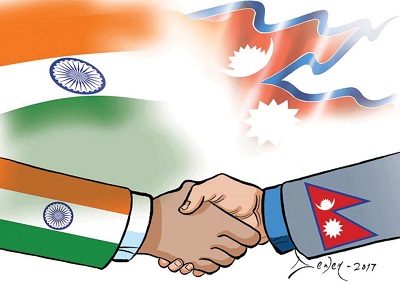Context:
Since 2015, there is now opportunity to upgrade the relationship to ‘positive’ and ‘stable’ with Mr. Modi having reclaimed the top post a third time and as Mr. Oli too comes out on top, in a unique collaboration between his CPN-UML and the Nepali Congress.
Historical Context of Bilateral Relations
- The Genesis of Turbulence : Relations between India and Nepal have significantly deteriorated since 2015 when both Narendra Modi and Khadga Prasad Oli were Prime Ministers. The bilateral turbulence began with the adoption of Nepal’s new Constitution by its Constituent Assembly in 2015, against New Delhi's wishes for amendments. Despite some politicians’ promises to Mr. Modi, the draft was promulgated unamended, leading to a devastating six-month blockade by India. This blockade, blamed on Madhesi activists by New Delhi, generated lasting bad blood.
- Impact of the Blockade : In response to the blockade, Mr. Oli signed 10 agreements with Beijing, covering trade, transit, power, and transport. Despite meetings after the blockade, tensions persisted, with Mr. Oli making provocative claims about Ayodhya and India’s national motto. A political map update by India in 2019 further strained relations, prompting Nepal to amend its Constitution to include the disputed Limpiyadhura-Kalapani triangle in its map.
- Re-evaluating the 1950 Treaty of Peace and Friendship : The 1950 Treaty between India and Nepal has historically given New Delhi significant influence over Kathmandu. However, many in Nepal feel that the treaty undermines their sovereignty, and Oli’s mandate reflects a push for a more independent Nepal. He stressed the need for both nations to respect each other’s concerns and sensitivities.
Key Issues
- Shifts in Political Dynamics : New Delhi's involvement in Nepali governance and politics deepened, marked by politico-diplomatic pressures and covert activities. The RSS and BJP sought to reshape Nepal in their image, exacerbating tensions. In Kathmandu, speculation abounds about Mr. Modi's intentions in his third term, considering the legacy of the blockade and Hindutva activism. With his foreign policy and national security teams remaining unchanged, questions arise about whether he will adopt a more conciliatory or assertive approach.
- Cross-Border Electricity Trade : A major topic during Oli’s visit was the issue of cross-border electricity trade. Oli insisted that such trade should follow the 2014 bilateral agreement, which allows non-discriminatory access for all authorized participants, rather than the restrictive 2016 guidelines from the Indian power ministry.
- Nepal’s Growing Ties with China : Oli's relationship with China has become a critical factor. Following the 2015 blockade, Nepal turned to China, signing a Trade and Transit Treaty in 2016 and joining the Belt and Road Initiative (BRI) in 2017. This growing partnership with Beijing has led New Delhi to reassess its approach and seek to strengthen ties with Nepal.
- Nepal’s Economic Contribution : Nepal is a significant remittance sender to India, supporting livelihoods in India’s poorest regions. New Delhi’s overbearing attitude appears to be based on power rather than prowess.

Building a Future-Oriented Partnership
- New Approach and Political Dynamics in Nepal : Nepal's political class has struggled to negotiate effectively with Indian counterparts due to internal turmoil. The recent tenure of Prime Minister Pushpa Kamal Dahal ('Prachanda') underscored a tendency to placate New Delhi, often at Nepal's expense. As Mr. Oli assumes leadership, he must assert Nepal's interests by addressing unresolved bilateral issues with confidence. Reviving the South Asian Association for Regional Cooperation (SAARC) is essential for regional stability.
- The Need for Policy Correction : The two Prime Ministers should leverage their current positions to resolve the bilateral impasse. Mr. Modi's 'Neighbourhood First' policy, which has faced challenges, could benefit from initiating policy adjustments regarding Nepal. New Delhi must recognize that adhering to the Panchsheel doctrine's principle of non-interference will result in a politically stable and economically vibrant Nepal, which in turn will enhance India's security and economy.
- India-Nepal Relations with China in the Background : New Delhi must accept that while Nepal’s friendship with Beijing is non-negotiable, it will not come at India’s expense. It is counterproductive for India to pressure Nepal on China-related issues while China remains India’s largest trading partner.
- The Role of the Eminent Persons’ Group (EPG) : Mr. Modi and Mr. Oli had nominated the EPG in 2017 to improve bilateral relations. The group’s consensus report, if implemented, could lead to a transparent, confident, and equal partnership.
- The Importance of a Cordial Relationship : The relationship must evolve beyond the dynamic of an overbearing New Delhi and a subservient Kathmandu. Nepal needs to assert its own voice, and India must reconsider its unsuccessful policy of interference. Nepal's natural stance is one of cordiality towards India, but New Delhi's paranoia, stemming from the 1962 conflict with China, impedes progress. Economists should acknowledge the military savings provided by Nepal's status as a benign buffer. The open border, often misrepresented as a security threat, is actually a model for a peaceful South Asia.
Conclusion
A lack of academic focus on Nepal in India contributes to misconceptions. It is Kathmandu’s responsibility to reach out and correct these views, promoting possibilities for cooperation. The Prime Ministers of India and Nepal, back in power, must rebuild trust and work towards a mutually beneficial relationship. New Delhi must accept Nepal as an independent country, moving from the ‘big brother’ role to simply being a ‘brother’.
|
Probable Questions for UPSC Mains
|
Source: The Hindu







